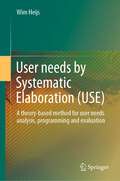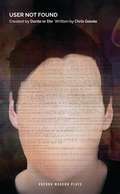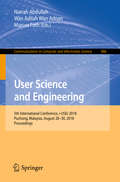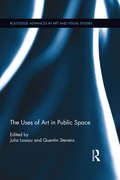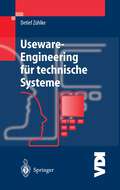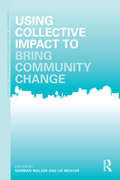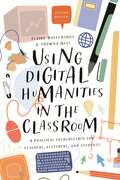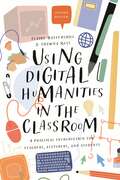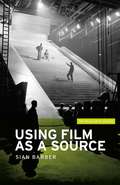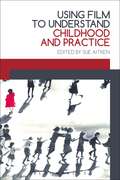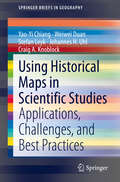- Table View
- List View
User Interfaces for Wearable Computers: Development and Evaluation (Advanced Studies Mobile Research Center Bremen)
by Hendrik WittHendrik Witt examines user interfaces for wearable computers and analyses the challenges imposed by the wearable computing paradigm through its dual-task character. He introduces a special software tool as well as the “HotWire” evaluation method to facilitate user interface development and evaluation. Based on the results of different end-user experiments conducted to study the management of interruptions with gesture and speech input in a wearable computing scenario, the author derives design guidelines and general constraints for forthcoming interface designs.
User needs by Systematic Elaboration (USE): A theory-based method for user needs analysis, programming and evaluation
by Wim HeijsThe design of a building can facilitate the process of use and promote the well-being of users if it meets their needs. Knowledge of user needs and processes of use is important for a good design. However, it is not self-evident what user needs really are, how user needs and processes of use can be researched, and how that knowledge can be used in a design. This book introduces an integrated methodology for the analysis of user needs, programming and evaluation that answers these questions. The purpose is to improve the interaction between the users and their environment and to avoid failure costs by facilitating proper design decisions. The theoretical perspective and the conceptual framework originate from environmental psychology, more specifically P-E fit theory. The target group consists of those who are interested in creating environments for people (designers, users, real estate managers; students and scientific staff). Designers are a special audience for whom the book can be a guide to working for and with users. The theoretical perspective and the conceptual framework can also be relevant for scientific research into the interaction between users and buildings.
User Not Found (Oberon Modern Plays)
by Chris Goode Dante Or DieIt’s the moment of your death.There’s a magic button.Do you delete your entire online legacy?Or do you keep it – and leave the choice for someone else?USER NOT FOUND is about our digital lives after we die. Dante or Die's new play, created with pioneering theatre-artist Chris Goode, is performed in cafés across the country, where you’ll be handed a smartphone and a pair of headphones. Become a fly-on-the-wall to peer into the life of a man who is faced with keeping or deleting. A story of contemporary grief unfolds through this intimate, funny performance that gently interrogates our need for connection.
The User Perspective on Twenty-First-Century Art Museums
by Georgia LindsayThe User Perspective on Twenty-First Century Art Museums explains contemporary museums from the whole gamut of user experiences, whether users are preserving art, creating an exhibit, visiting, or part of institutions that use the architecture for branding. Fourteen museums from the United States, Europe, China, and Australia represent new construction, repurposed buildings, and additions, offering examples for most museum design situations. Each is examined using interviews with key stakeholders, photographs, and analyses of press coverage to identify lessons from the main user groups. User groups vary from project to project depending on conditions and context, so each of the four parts of the book features a summary of the users and issues in that section for quick reference. The book concludes with a practical, straightforward lessons-learned summary and a critical assessment of twenty-first-century museum architecture, programming, and expectations to help you embark on a new building design. Architects, architecture students, museum professionals, and aficionados of museum design will all find helpful insights in these lessons and critiques.
The User Perspective on Twenty-First-Century Art Museums
by Georgia LindsayThe User Perspective on Twenty-First Century Art Museums explains contemporary museums from the whole gamut of user experiences, whether users are preserving art, creating an exhibit, visiting, or part of institutions that use the architecture for branding. Fourteen museums from the United States, Europe, China, and Australia represent new construction, repurposed buildings, and additions, offering examples for most museum design situations. Each is examined using interviews with key stakeholders, photographs, and analyses of press coverage to identify lessons from the main user groups. User groups vary from project to project depending on conditions and context, so each of the four parts of the book features a summary of the users and issues in that section for quick reference. The book concludes with a practical, straightforward lessons-learned summary and a critical assessment of twenty-first-century museum architecture, programming, and expectations to help you embark on a new building design. Architects, architecture students, museum professionals, and aficionados of museum design will all find helpful insights in these lessons and critiques.
User Science and Engineering: 5th International Conference, i-USEr 2018, Puchong, Malaysia, August 28–30, 2018, Proceedings (Communications in Computer and Information Science #886)
by Natrah Abdullah Wan Adilah Wan Adnan Marcus FothThis book constitutes the refereed proceedings of the 5th International Conference on User Science and Engineering, i-USEr 2018, held in Puchong, Malaysia, in August 2018. The 32 papers accepted for i-USEr 2018 were selected from 72 submissions with a thorough double-blind review process. The selected papers illustrate how HCI is inclusive and omnipresent within the domains of informatics, Internet of Things, Quality of Life, and others. They are organized in the following topical sections: design, UX and usability; HCI and underserved; technology and adoption; human centered computing; HCI and IT infrastructure; and HCI and analytics.
A User's Guide to the View Camera: Third Edition
by Jim StoneThis reissued third edition of A User’s Guide to View Camera introduces photographers to large-format cameras, covering their use with both film and digital capture. Readers will learn the anatomy of cameras with a separately adjustable back or front, the proper techniques for using view cameras, and how to take care of large-format cameras—all through straightforward and practical instruction and abundant visual examples. This latest edition features: • Practical approaches to mastering lenses, shutters, accessories, and the ever-important maintenance of your view camera • Tips for both simple operation and advanced control of the camera, including film holders, bellows, and tripods, and film handling and development • A section on digital equipment, offering updates on the nearly 200-year-long history of the view camera
A User's Guide to the View Camera: Third Edition
by Jim StoneThis reissued third edition of A User’s Guide to View Camera introduces photographers to large-format cameras, covering their use with both film and digital capture. Readers will learn the anatomy of cameras with a separately adjustable back or front, the proper techniques for using view cameras, and how to take care of large-format cameras—all through straightforward and practical instruction and abundant visual examples. This latest edition features: • Practical approaches to mastering lenses, shutters, accessories, and the ever-important maintenance of your view camera • Tips for both simple operation and advanced control of the camera, including film holders, bellows, and tripods, and film handling and development • A section on digital equipment, offering updates on the nearly 200-year-long history of the view camera
The Uses of Art in Public Space (Routledge Advances in Art and Visual Studies)
by Julia Lossau Quentin StevensThis book links two fields of interest which are too seldom considered together: the production and critique of art in public space and social behaviour in the public realm. Whilst most writing about public art has focused on the aesthetic, cultural and political intentions and processes that shape its production, this edited collection examines a variety of public artworks from the perspective of their actual everyday use. Contributors are interested in the rich diversity of peoples’ engagements with public artworks across various spatial and temporal scales, encounters which do not limit themselves to the representational aspects of the art, and which are not necessarily as the artist, curator or sponsor intended. Case studies consider a broad range of public art, including commissioned and unofficial artworks, memorials, street art, street furniture, performance art, sound art and media installations.
The Uses of Art in Public Space (Routledge Advances in Art and Visual Studies)
by Julia Lossau Quentin StevensThis book links two fields of interest which are too seldom considered together: the production and critique of art in public space and social behaviour in the public realm. Whilst most writing about public art has focused on the aesthetic, cultural and political intentions and processes that shape its production, this edited collection examines a variety of public artworks from the perspective of their actual everyday use. Contributors are interested in the rich diversity of peoples’ engagements with public artworks across various spatial and temporal scales, encounters which do not limit themselves to the representational aspects of the art, and which are not necessarily as the artist, curator or sponsor intended. Case studies consider a broad range of public art, including commissioned and unofficial artworks, memorials, street art, street furniture, performance art, sound art and media installations.
The Uses of Reason in the Evaluation of Artworks: Commentaries on the Turner Prize
by Les GillonThis book uses an examination of the annual Turner Prize to defend the view that the evaluation of artworks is a reason-based activity, notwithstanding the lack of any agreed criteria for judging excellence in art. It undertakes an empirical investigation of actual critical practice as evident within published commentaries on the Prize in order to examine and test theories of critical evaluation, including the ideas of Noel Carroll, Frank Sibley, Kendall Walton and Suzanne Langer. Case studies of work by Turner Prize winners such as Steve McQueen, Martin Creed, Tomma Abts are used to explore definitions of art and concepts of artistic value and meaning. The book will be of interest to academics in the fields of aesthetics, contemporary art and cultural studies, but also to practitioners working in the arts, media and education.
The Uses of Reason in the Evaluation of Artworks: Commentaries on the Turner Prize
by Les GillonThis book uses an examination of the annual Turner Prize to defend the view that the evaluation of artworks is a reason-based activity, notwithstanding the lack of any agreed criteria for judging excellence in art. It undertakes an empirical investigation of actual critical practice as evident within published commentaries on the Prize in order to examine and test theories of critical evaluation, including the ideas of Noel Carroll, Frank Sibley, Kendall Walton and Suzanne Langer. Case studies of work by Turner Prize winners such as Steve McQueen, Martin Creed, Tomma Abts are used to explore definitions of art and concepts of artistic value and meaning. The book will be of interest to academics in the fields of aesthetics, contemporary art and cultural studies, but also to practitioners working in the arts, media and education.
Useware-Engineering für technische Systeme (VDI-Buch)
by Detlef ZühlkeMit dem Begriff Useware ist eine Fokussierung der Technikgestaltung auf menschliche Fähigkeiten und Bedürfnisse an der Mensch-Maschine-Schnittstelle verbunden. Das Buch hilft Entwicklern in der Industrie und Forschung mit praktisch orientierten Beispielen für Gestaltungslösungen. Eine kurze Erläuterung der menschlichen Fähigkeiten erhöht das Verständnis für die Vorgehensweise bei der Gestaltung komplexer Useware-Systeme, die detailliert dargestellt wird.
Using and Conquering the Watery World in Greco-Roman Antiquity
by Georgia L. IrbyThis volume considers how Greco-Roman authorities manipulated water on the practical, technological, and political levels. Water was controlled and harnessed with legal oversight and civic infrastructure (e.g., aqueducts). Waterways were 'improved' and made accessible by harbors, canals, and lighthouses. The Mediterranean Sea and Outer Ocean (and numerous rivers) were mastered by navigation for warfare, exploration, settlement, maritime trade, and the exploitation of marine resources (such as fishing). These waterways were also a robust source of propaganda on coins, public monuments, and poetic encomia as governments vied to establish, maintain, or spread their identities and predominance. This first complete study of the ancient scientific and public engagement with water makes a major contribution to classics, geography, hydrology and the history of science alike. In the ancient Mediterranean Basin, water was a powerful tool of human endeavor, employed for industry, trade, hunting and fishing, and as an element in luxurious aesthetic installations (public and private fountains). The relationship was complex and pervasive, touching on every aspect of human life, from mundane acts of collecting water for the household, to private and public issues of comfort and health (latrines, sewers, baths), to the identity of the state writ large.
Using and Conquering the Watery World in Greco-Roman Antiquity
by Georgia L. IrbyThis volume considers how Greco-Roman authorities manipulated water on the practical, technological, and political levels. Water was controlled and harnessed with legal oversight and civic infrastructure (e.g., aqueducts). Waterways were 'improved' and made accessible by harbors, canals, and lighthouses. The Mediterranean Sea and Outer Ocean (and numerous rivers) were mastered by navigation for warfare, exploration, settlement, maritime trade, and the exploitation of marine resources (such as fishing). These waterways were also a robust source of propaganda on coins, public monuments, and poetic encomia as governments vied to establish, maintain, or spread their identities and predominance. This first complete study of the ancient scientific and public engagement with water makes a major contribution to classics, geography, hydrology and the history of science alike. In the ancient Mediterranean Basin, water was a powerful tool of human endeavor, employed for industry, trade, hunting and fishing, and as an element in luxurious aesthetic installations (public and private fountains). The relationship was complex and pervasive, touching on every aspect of human life, from mundane acts of collecting water for the household, to private and public issues of comfort and health (latrines, sewers, baths), to the identity of the state writ large.
Using Collective Impact to Bring Community Change (Community Development Research and Practice Series)
by Norman Walzer Liz WeaverCollective Impact as a tool to bring about community change has seen remarkable growth in usage since 2011. Collective Impact has been used successfully with a variety of local issues and has raised the consciousness of how community groups interact as well as the approaches that can lead to long-term innovations. This edited volume sets forth conceptual foundations for using Collective Impact as well as sharing basic approaches that have succeeded in projects under diverse circumstances. It will be useful for both academics and practitioners as Collective Impact continues to undergo substantial changes in focus and direction. Building on Kania and Kramer’s influential work, it provides readers with detailed insights not only into how the Collective Impact system works but also innovative applications to issues facing community developers. The diverse topics shared by the contributing authors make this volume especially important for practitioners designing programs to bring about long-term changes in their communities. Including discussion about how Collective Impact has succeeded in different governmental settings, this book demonstrates how Collective Impact has been modified to accommodate the associated cultural differences with 10 chapters written by experienced on-the-ground community development experts.
Using Collective Impact to Bring Community Change (Community Development Research and Practice Series)
by Norman Walzer Liz WeaverCollective Impact as a tool to bring about community change has seen remarkable growth in usage since 2011. Collective Impact has been used successfully with a variety of local issues and has raised the consciousness of how community groups interact as well as the approaches that can lead to long-term innovations. This edited volume sets forth conceptual foundations for using Collective Impact as well as sharing basic approaches that have succeeded in projects under diverse circumstances. It will be useful for both academics and practitioners as Collective Impact continues to undergo substantial changes in focus and direction. Building on Kania and Kramer’s influential work, it provides readers with detailed insights not only into how the Collective Impact system works but also innovative applications to issues facing community developers. The diverse topics shared by the contributing authors make this volume especially important for practitioners designing programs to bring about long-term changes in their communities. Including discussion about how Collective Impact has succeeded in different governmental settings, this book demonstrates how Collective Impact has been modified to accommodate the associated cultural differences with 10 chapters written by experienced on-the-ground community development experts.
Using Data Science and Landscape Approach to Sustain Historic Cities
by Ali Moazzeni KhorasganiThis book comprehensively explores sustaining historic cities using a landscape approach and data science. The author offers valuable insights for professionals and enthusiasts interested in preserving and developing urban heritage through a data driven approach. Drawing on the synergy between landscape architecture and data science, the book delves into the intricate interplay between historical, cultural, and environmental factors in urban settings. Readers will understand how to navigate historic cities' complex challenges through case studies, research findings, and practical methodologies. The book equips readers with innovative strategies for preserving the authenticity of these cities while embracing sustainable development practices. By blending theory and real-world applications, this book is a comprehensive guide for creating thriving, resilient, and culturally rich urban environments.
Using Digital Humanities in the Classroom: A Practical Introduction for Teachers, Lecturers, and Students
by Claire Battershill Shawna RossRooted in the day-to-day experience of teaching and written for those without specialist technical knowledge, this is a new edition of the go-to guide to using digital tools and resources in the humanities classroom. In response to the rapidly changing nature of the field, this new edition has been updated throughout and now features:- A brand-new Preface accounting for new developments in the broader field of DH pedagogy- New chapters on 'Collaborating' and on 'Teaching in a Digital Classroom' - New sections on collaborating with other teachers; teaching students with learning differences; explaining the benefits of digital pedagogy to your students; and advising graduate students about the technologies they need to master- New 'advanced activities' and 'advanced assignment' sections (including bots, vlogging, crowd-sourcing, digital storytelling, web scraping, critical making, automatic text generation, and digital media art)- Expanded chapter bibliographies and over two dozen tables offering practical advice on choosing software programsAccompanied by a streamlined companion website, which has been entirely redesigned to answer commonly asked questions quickly and clearly, this is essential reading for anyone looking to incorporate digital tools and resources into their daily teaching.
Using Digital Humanities in the Classroom: A Practical Introduction for Teachers, Lecturers, and Students
by Claire Battershill Shawna RossRooted in the day-to-day experience of teaching and written for those without specialist technical knowledge, this is a new edition of the go-to guide to using digital tools and resources in the humanities classroom. In response to the rapidly changing nature of the field, this new edition has been updated throughout and now features:- A brand-new Preface accounting for new developments in the broader field of DH pedagogy- New chapters on 'Collaborating' and on 'Teaching in a Digital Classroom' - New sections on collaborating with other teachers; teaching students with learning differences; explaining the benefits of digital pedagogy to your students; and advising graduate students about the technologies they need to master- New 'advanced activities' and 'advanced assignment' sections (including bots, vlogging, crowd-sourcing, digital storytelling, web scraping, critical making, automatic text generation, and digital media art)- Expanded chapter bibliographies and over two dozen tables offering practical advice on choosing software programsAccompanied by a streamlined companion website, which has been entirely redesigned to answer commonly asked questions quickly and clearly, this is essential reading for anyone looking to incorporate digital tools and resources into their daily teaching.
Using film as a source (IHR Research Guides)
by Sian BarberThis book is a hands-on study skills guide that explores how film and moving image can be used as sources. It is aimed at those who want to use film and moving image as the basis for research and offers advice on research methods, theory and methodology, archival work and film-based analysis. It draws on the disciplines of film and history to offer advice for students and researchers in these fields. The book includes sections on working with different kinds of moving images, how to explore visual sources, how to undertake film-related research and how to use film theory. In addition to providing detailed case studies, the guide also offers advice on research, writing and studying, creating a methodology, visiting archives, accessing material and exploring films from a historical perspective. The guide's focus is on good research practice, whether it be conducting an interview, visiting an archive, undertaking textual analysis or defining a research question.
Using film as a source (IHR Research Guides)
by Sian BarberThis book is a hands-on study skills guide that explores how film and moving image can be used as sources. It is aimed at those who want to use film and moving image as the basis for research and offers advice on research methods, theory and methodology, archival work and film-based analysis. It draws on the disciplines of film and history to offer advice for students and researchers in these fields. The book includes sections on working with different kinds of moving images, how to explore visual sources, how to undertake film-related research and how to use film theory. In addition to providing detailed case studies, the guide also offers advice on research, writing and studying, creating a methodology, visiting archives, accessing material and exploring films from a historical perspective. The guide's focus is on good research practice, whether it be conducting an interview, visiting an archive, undertaking textual analysis or defining a research question.
Using Film to Understand Childhood and Practice
by Sue AitkenUsing Film to Understand Childhood and Practice is an innovative and lively text which allows complex and challenging issues within childhood studies to be explored using the medium of filmed drama. By utilising popular culture, this book provides accessible narratives to students and lecturers needing to engage with complex theoretical ideas. In exposing theories to tangible situations often from more than one perspective in films, readers are helped to identify and recognise how theories about children and childhood can be applied. Each chapter uses a specific film to provide the basis for discussion in order to explore and analyse key concepts within childhood studies which include identity, social construction, families, political and biological narratives, children's rights and participation. A range of international films are used including Charlie and the Chocolate Factory, Rabbit Proof Fence, The Hunger Games and The Red Balloon. First introducing the theoretical perspective to be discussed, chapters also include a contextual explanation of the film and list the specific scenes that will be used to guide students through. Concluding with discussion questions, students are asked to consider how the theories discussed might be translated in to their own experiences of children, childhood and practice. Not only supporting understanding of core principles and key ideas across any childhood studies degree, this book supports students throughout their university career and beyond by engaging with the journey of becoming a graduate as well as discussion of workplace issues and concepts after graduation.
Using Film to Understand Childhood and Practice
by Sue AitkenUsing Film to Understand Childhood and Practice is an innovative and lively text which allows complex and challenging issues within childhood studies to be explored using the medium of filmed drama. By utilising popular culture, this book provides accessible narratives to students and lecturers needing to engage with complex theoretical ideas. In exposing theories to tangible situations often from more than one perspective in films, readers are helped to identify and recognise how theories about children and childhood can be applied. Each chapter uses a specific film to provide the basis for discussion in order to explore and analyse key concepts within childhood studies which include identity, social construction, families, political and biological narratives, children's rights and participation. A range of international films are used including Charlie and the Chocolate Factory, Rabbit Proof Fence, The Hunger Games and The Red Balloon. First introducing the theoretical perspective to be discussed, chapters also include a contextual explanation of the film and list the specific scenes that will be used to guide students through. Concluding with discussion questions, students are asked to consider how the theories discussed might be translated in to their own experiences of children, childhood and practice. Not only supporting understanding of core principles and key ideas across any childhood studies degree, this book supports students throughout their university career and beyond by engaging with the journey of becoming a graduate as well as discussion of workplace issues and concepts after graduation.
Using Historical Maps in Scientific Studies: Applications, Challenges, and Best Practices (SpringerBriefs in Geography)
by Yao-Yi Chiang Weiwei Duan Stefan Leyk Johannes H. Uhl Craig A. KnoblockThis book illustrates the first connection between the map user community and the developers of digital map processing technologies by providing several applications, challenges, and best practices in working with historical maps. After the introduction chapter, in this book, Chapter 2 presents a variety of existing applications of historical maps to demonstrate varying needs for processing historical maps in scientific studies (e.g., thousands of historical maps from a map series vs. a few historical maps from various publishers and with different cartographic styles). Chapter 2 also describes case studies introducing typical types of semi-automatic and automatic digital map processing technologies. The case studies showcase the strengths and weaknesses of semi-automatic and automatic approaches by testing them in a symbol recognition task on the same scanned map. Chapter 3 presents the technical challenges and trends in building a map processing, modeling, linking, and publishing framework. The framework will enable querying historical map collections as a unified and structured spatiotemporal source in which individual geographic phenomena (extracted from maps) are modeled (described) with semantic descriptions and linked to other data sources (e.g., DBpedia, a structured version of Wikipedia). Chapter 4 dives into the recent advancement in deep learning technologies and their applications on digital map processing. The chapter reviews existing deep learning models for their capabilities on geographic feature extraction from historical maps and compares different types of training strategies. A comprehensive experiment is described to compare different models and their performance.Historical maps are fascinating to look at and contain valuable retrospective place information difficult to find elsewhere. However, the full potential of historical maps has not been realized because the users of scanned historical maps and the developers of digital map processing technologies are from a wide range of disciplines and often work in silos. Each chapter in this book can be read individually, but the order of chapters in this book helps the reader to first understand the “product requirements” of a successful digital map processing system, then review the existing challenges and technologies, and finally follow the more recent trend of deep learning applications for processing historical maps. The primary audience for this book includes scientists and researchers whose work requires long-term historical geographic data as well as librarians. The secondary audience includes anyone who loves maps!

